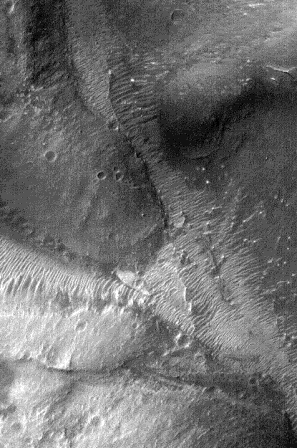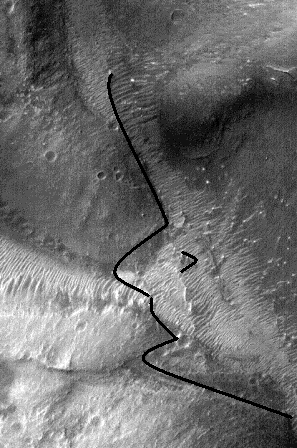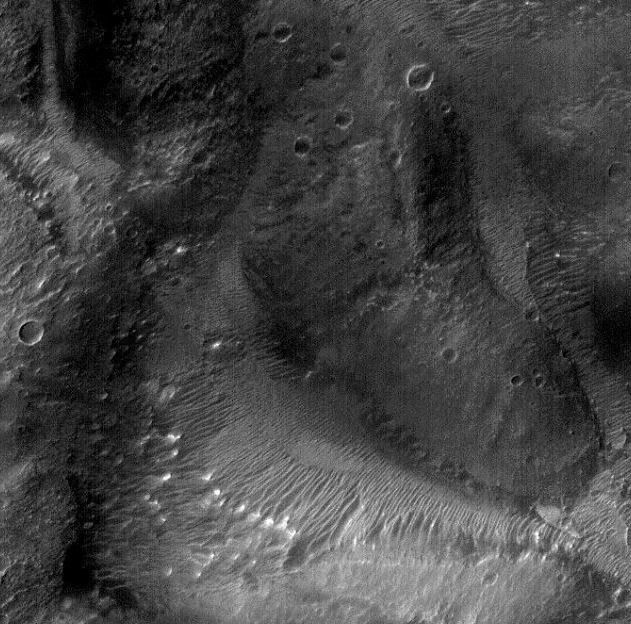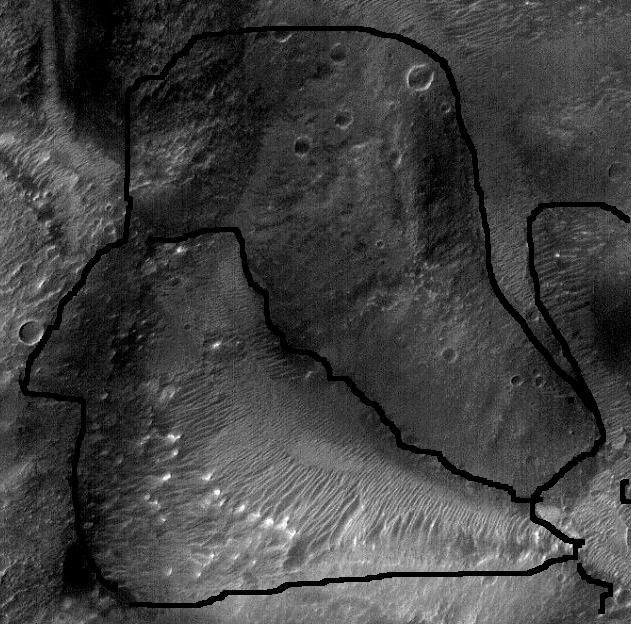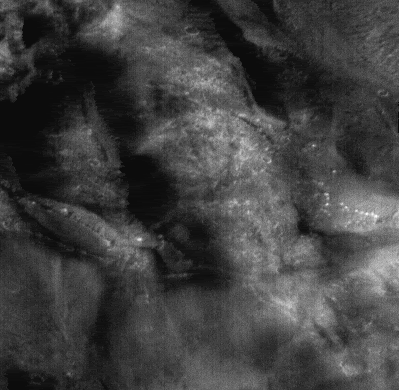- Thank you received: 0
Faces from the Chasmas
- neilderosa
-
- Offline
- Platinum Member
-

Less
More
18 years 7 months ago #17430
by neilderosa
Replied by neilderosa on topic Reply from Neil DeRosa
(deleted duplicate)
Please Log in or Create an account to join the conversation.
- neilderosa
-
- Offline
- Platinum Member
-

Less
More
- Thank you received: 0
18 years 7 months ago #17548
by neilderosa
Replied by neilderosa on topic Reply from Neil DeRosa
<blockquote id="quote"><font size="2" face="Verdana, Arial, Helvetica" id="quote">quote:<hr height="1" noshade id="quote"><i>Originally posted by neilderosa</i>
<br />The Scullface mosaic was to my knowledge the first artifact including faces found in the west Candor Chasma, and was one of the reasons I made my extensive search there.
It was first imaged in AB108403 at the oblique emission angle angel of 35.55° from the perpendicular, and at a resolution of 4.67 m/p. In a paper on the subject, JP Levasseur and Horace Crater made some quite extraordinary claims as to the nature of the mosaic, but then subsequently backed off of some of those claims when the feature was later imaged in R1901775 as a public request image.
Peer reviewed paper: spsr.utsi.edu/
Image sources:
www.msss.com/moc_gallery/ab1_m04/images/AB108403.html
www.msss.com/mars_images/moc/publicresul...04/07/R19-01775p.gif
This topic was discussed previously on this MB; but the conclusions, if any, were unsatisfactory. Recently I decided to look at the evidence in a little more detail. As noted, the emission angle in the AB1 image was unusually oblique. All this means is that if seen from directly overhead, the mosaic would look somewhat different; elongated in some respects, and foreshortened in others. But there is no reason that this one factor would necessarily negate the results of the original Levasseur, Crater study.
The thing that struck an almost fatal blow to the authors’ conclusions was the subsequent image taken, R1901775. At first glance this image appears to be a much higher resolution image. But at 3.01 m/p it is less than twice the magnification of the original, perhaps also receiving better lighting and other unknown imaging advantages. The R19 image appears much more “pocked marked” and “flawed” than the original, causing skeptics and cautious observers to conclude once again that here was just another “pile of rocks.”
But on careful re-examination we see that this is not so. The new image reveals all of the clues of artificiality of the original, and more; (including proportionality, theme, orientation, detail etc.,). Its biggest drawback was that it imaged only a small portion of the original mosaic, making it very difficult to put the new information into context. To resolve this difficulty, I created a composite (or rather two composites) melding the two images together. One other factor causing some slight difficulty in creating a composite was that the new image has a markedly different camera (emission) angle, (18.29°), thus preventing an exact match-up of the two images. Also, in order to match up the two images, it was necessary to free rotate one of the images to match the viewing angle of the other. However we got it close enough to make our point. Here’s what we found.
1- The left (west) eye of the Scullface figure is present in both images, as is the shading that was originally interpreted as a “mouth” and “right eye.”
2- At the upper right of the SF “scull” is a circular line which seemed odd and out of place in R19. But in the mosaic composite we can see that it is just as in the original. Moreover, it is now fairly clear that it is an inscribed line in the original rock (by the artist) in order to make the rock appear more like a scull.
3- The “oriental lady” who I will call the “Nurse,” is as clear as in the original. While her profile outline is still obscure, (this may be the effects of erosion), she now reveals a well defined “eye,” and looks less “oriental.”
4- Behind the Nurse, is another profile of a woman who I’ll call the “Observer.” This is a remarkable new find because we see here a clue to something I’ve often suspected. Namely, the artists often use the natural terrain in their mosaics and modify it in some way while retaining many of the natural structures. This is a method that has often been employed in earth architecture to good artistic effect, and is hence nothing unusual to us.
5- In the Observer as well as in the Nurse figure, natural rock outcropping seems to have been used to depict a “hairdo.” But the Observer’s profile is clearly outlined and still clearly visible despite erosion. Remarkably, we can see the outline of the Observer’s “nose” inscribed (by the artist) right through the corner of the natural outcropping that serves as the hairdo of the Nurse. This seems almost a “smoking gun,” i.e. a tell-tale clue to artificiality.
Once again, the Observer.
And Key.
Neil
<hr height="1" noshade id="quote"></blockquote id="quote"></font id="quote">
<br />The Scullface mosaic was to my knowledge the first artifact including faces found in the west Candor Chasma, and was one of the reasons I made my extensive search there.
It was first imaged in AB108403 at the oblique emission angle angel of 35.55° from the perpendicular, and at a resolution of 4.67 m/p. In a paper on the subject, JP Levasseur and Horace Crater made some quite extraordinary claims as to the nature of the mosaic, but then subsequently backed off of some of those claims when the feature was later imaged in R1901775 as a public request image.
Peer reviewed paper: spsr.utsi.edu/
Image sources:
www.msss.com/moc_gallery/ab1_m04/images/AB108403.html
www.msss.com/mars_images/moc/publicresul...04/07/R19-01775p.gif
This topic was discussed previously on this MB; but the conclusions, if any, were unsatisfactory. Recently I decided to look at the evidence in a little more detail. As noted, the emission angle in the AB1 image was unusually oblique. All this means is that if seen from directly overhead, the mosaic would look somewhat different; elongated in some respects, and foreshortened in others. But there is no reason that this one factor would necessarily negate the results of the original Levasseur, Crater study.
The thing that struck an almost fatal blow to the authors’ conclusions was the subsequent image taken, R1901775. At first glance this image appears to be a much higher resolution image. But at 3.01 m/p it is less than twice the magnification of the original, perhaps also receiving better lighting and other unknown imaging advantages. The R19 image appears much more “pocked marked” and “flawed” than the original, causing skeptics and cautious observers to conclude once again that here was just another “pile of rocks.”
But on careful re-examination we see that this is not so. The new image reveals all of the clues of artificiality of the original, and more; (including proportionality, theme, orientation, detail etc.,). Its biggest drawback was that it imaged only a small portion of the original mosaic, making it very difficult to put the new information into context. To resolve this difficulty, I created a composite (or rather two composites) melding the two images together. One other factor causing some slight difficulty in creating a composite was that the new image has a markedly different camera (emission) angle, (18.29°), thus preventing an exact match-up of the two images. Also, in order to match up the two images, it was necessary to free rotate one of the images to match the viewing angle of the other. However we got it close enough to make our point. Here’s what we found.
1- The left (west) eye of the Scullface figure is present in both images, as is the shading that was originally interpreted as a “mouth” and “right eye.”
2- At the upper right of the SF “scull” is a circular line which seemed odd and out of place in R19. But in the mosaic composite we can see that it is just as in the original. Moreover, it is now fairly clear that it is an inscribed line in the original rock (by the artist) in order to make the rock appear more like a scull.
3- The “oriental lady” who I will call the “Nurse,” is as clear as in the original. While her profile outline is still obscure, (this may be the effects of erosion), she now reveals a well defined “eye,” and looks less “oriental.”
4- Behind the Nurse, is another profile of a woman who I’ll call the “Observer.” This is a remarkable new find because we see here a clue to something I’ve often suspected. Namely, the artists often use the natural terrain in their mosaics and modify it in some way while retaining many of the natural structures. This is a method that has often been employed in earth architecture to good artistic effect, and is hence nothing unusual to us.
5- In the Observer as well as in the Nurse figure, natural rock outcropping seems to have been used to depict a “hairdo.” But the Observer’s profile is clearly outlined and still clearly visible despite erosion. Remarkably, we can see the outline of the Observer’s “nose” inscribed (by the artist) right through the corner of the natural outcropping that serves as the hairdo of the Nurse. This seems almost a “smoking gun,” i.e. a tell-tale clue to artificiality.
Once again, the Observer.
And Key.
Neil
<hr height="1" noshade id="quote"></blockquote id="quote"></font id="quote">
Please Log in or Create an account to join the conversation.
- neilderosa
-
- Offline
- Platinum Member
-

Less
More
- Thank you received: 0
18 years 7 months ago #16248
by neilderosa
Replied by neilderosa on topic Reply from Neil DeRosa
<blockquote id="quote"><font size="2" face="Verdana, Arial, Helvetica" id="quote">quote:<hr height="1" noshade id="quote"><i>Originally posted by neilderosa</i>
<br /><blockquote id="quote"><font size="2" face="Verdana, Arial, Helvetica" id="quote">quote:<hr height="1" noshade id="quote"><i>Originally posted by neilderosa</i>
<br />The Scullface mosaic was to my knowledge the first artifact including faces found in the west Candor Chasma, and was one of the reasons I made my extensive search there.
It was first imaged in AB108403 at the oblique emission angle angel of 35.55° from the perpendicular, and at a resolution of 4.67 m/p. In a paper on the subject, JP Levasseur and Horace Crater made some quite extraordinary claims as to the nature of the mosaic, but then subsequently backed off of some of those claims when the feature was later imaged in R1901775 as a public request image.
Peer reviewed paper: spsr.utsi.edu/
Image sources:
www.msss.com/moc_gallery/ab1_m04/images/AB108403.html
www.msss.com/mars_images/moc/publicresul...04/07/R19-01775p.gif
This topic was discussed previously on this MB; but the conclusions, if any, were unsatisfactory. Recently I decided to look at the evidence in a little more detail. As noted, the emission angle in the AB1 image was unusually oblique. All this means is that if seen from directly overhead, the mosaic would look somewhat different; elongated in some respects, and foreshortened in others. But there is no reason that this one factor would necessarily negate the results of the original Levasseur, Crater study.
The thing that struck an almost fatal blow to the authors’ conclusions was the subsequent image taken, R1901775. At first glance this image appears to be a much higher resolution image. But at 3.01 m/p it is less than twice the magnification of the original, perhaps also receiving better lighting and other unknown imaging advantages. The R19 image appears much more “pocked marked” and “flawed” than the original, causing skeptics and cautious observers to conclude once again that here was just another “pile of rocks.”
But on careful re-examination we see that this is not so. The new image reveals all of the clues of artificiality of the original, and more; (including proportionality, theme, orientation, detail etc.,). Its biggest drawback was that it imaged only a small portion of the original mosaic, making it very difficult to put the new information into context. To resolve this difficulty, I created a composite (or rather two composites) melding the two images together. One other factor causing some slight difficulty in creating a composite was that the new image has a markedly different camera (emission) angle, (18.29°), thus preventing an exact match-up of the two images. Also, in order to match up the two images, it was necessary to free rotate one of the images to match the viewing angle of the other. However we got it close enough to make our point. Here’s what we found.
1- The left (west) eye of the Scullface figure is present in both images, as is the shading that was originally interpreted as a “mouth” and “right eye.”
2- At the upper right of the SF “scull” is a circular line which seemed odd and out of place in R19. But in the mosaic composite we can see that it is just as in the original. Moreover, it is now fairly clear that it is an inscribed line in the original rock (by the artist) in order to make the rock appear more like a scull.
3- The “oriental lady” who I will call the “Nurse,” is as clear as in the original. While her profile outline is still obscure, (this may be the effects of erosion), she now reveals a well defined “eye,” and looks less “oriental.”
4- Behind the Nurse, is another profile of a woman who I’ll call the “Observer.” This is a remarkable new find because we see here a clue to something I’ve long suspected. Namely, the artists often use the natural terrain in their mosaics and modify it in some way while retaining many of the natural structures. This is a method that has often been employed in earth architecture to good artistic effect, and is hence nothing unusual to us.
5- In the Observer as well as in the Nurse figure, natural rock outcropping seems to have been used to depict a “hairdo.” But the Observer’s profile is clearly outlined and still clearly visible despite erosion. Remarkably, we can see the outline of the Observer’s “nose” inscribed (by the artist) right through the corner of the natural outcropping that serves as the hairdo of the Nurse. This seems almost a “smoking gun,” i.e. a tell-tale clue to artificiality.
Once again, the Observer.
And Key.
Neil
<hr height="1" noshade id="quote"></blockquote id="quote"></font id="quote">
<hr height="1" noshade id="quote"></blockquote id="quote"></font id="quote">
<br /><blockquote id="quote"><font size="2" face="Verdana, Arial, Helvetica" id="quote">quote:<hr height="1" noshade id="quote"><i>Originally posted by neilderosa</i>
<br />The Scullface mosaic was to my knowledge the first artifact including faces found in the west Candor Chasma, and was one of the reasons I made my extensive search there.
It was first imaged in AB108403 at the oblique emission angle angel of 35.55° from the perpendicular, and at a resolution of 4.67 m/p. In a paper on the subject, JP Levasseur and Horace Crater made some quite extraordinary claims as to the nature of the mosaic, but then subsequently backed off of some of those claims when the feature was later imaged in R1901775 as a public request image.
Peer reviewed paper: spsr.utsi.edu/
Image sources:
www.msss.com/moc_gallery/ab1_m04/images/AB108403.html
www.msss.com/mars_images/moc/publicresul...04/07/R19-01775p.gif
This topic was discussed previously on this MB; but the conclusions, if any, were unsatisfactory. Recently I decided to look at the evidence in a little more detail. As noted, the emission angle in the AB1 image was unusually oblique. All this means is that if seen from directly overhead, the mosaic would look somewhat different; elongated in some respects, and foreshortened in others. But there is no reason that this one factor would necessarily negate the results of the original Levasseur, Crater study.
The thing that struck an almost fatal blow to the authors’ conclusions was the subsequent image taken, R1901775. At first glance this image appears to be a much higher resolution image. But at 3.01 m/p it is less than twice the magnification of the original, perhaps also receiving better lighting and other unknown imaging advantages. The R19 image appears much more “pocked marked” and “flawed” than the original, causing skeptics and cautious observers to conclude once again that here was just another “pile of rocks.”
But on careful re-examination we see that this is not so. The new image reveals all of the clues of artificiality of the original, and more; (including proportionality, theme, orientation, detail etc.,). Its biggest drawback was that it imaged only a small portion of the original mosaic, making it very difficult to put the new information into context. To resolve this difficulty, I created a composite (or rather two composites) melding the two images together. One other factor causing some slight difficulty in creating a composite was that the new image has a markedly different camera (emission) angle, (18.29°), thus preventing an exact match-up of the two images. Also, in order to match up the two images, it was necessary to free rotate one of the images to match the viewing angle of the other. However we got it close enough to make our point. Here’s what we found.
1- The left (west) eye of the Scullface figure is present in both images, as is the shading that was originally interpreted as a “mouth” and “right eye.”
2- At the upper right of the SF “scull” is a circular line which seemed odd and out of place in R19. But in the mosaic composite we can see that it is just as in the original. Moreover, it is now fairly clear that it is an inscribed line in the original rock (by the artist) in order to make the rock appear more like a scull.
3- The “oriental lady” who I will call the “Nurse,” is as clear as in the original. While her profile outline is still obscure, (this may be the effects of erosion), she now reveals a well defined “eye,” and looks less “oriental.”
4- Behind the Nurse, is another profile of a woman who I’ll call the “Observer.” This is a remarkable new find because we see here a clue to something I’ve long suspected. Namely, the artists often use the natural terrain in their mosaics and modify it in some way while retaining many of the natural structures. This is a method that has often been employed in earth architecture to good artistic effect, and is hence nothing unusual to us.
5- In the Observer as well as in the Nurse figure, natural rock outcropping seems to have been used to depict a “hairdo.” But the Observer’s profile is clearly outlined and still clearly visible despite erosion. Remarkably, we can see the outline of the Observer’s “nose” inscribed (by the artist) right through the corner of the natural outcropping that serves as the hairdo of the Nurse. This seems almost a “smoking gun,” i.e. a tell-tale clue to artificiality.
Once again, the Observer.
And Key.
Neil
<hr height="1" noshade id="quote"></blockquote id="quote"></font id="quote">
<hr height="1" noshade id="quote"></blockquote id="quote"></font id="quote">
Please Log in or Create an account to join the conversation.
18 years 7 months ago #16250
by rderosa
Replied by rderosa on topic Reply from Richard DeRosa
<blockquote id="quote"><font size="2" face="Verdana, Arial, Helvetica" id="quote">quote:<hr height="1" noshade id="quote"><i>Originally posted by neilderosa</i>
<br />Once again, the Observer.<hr height="1" noshade id="quote"></blockquote id="quote"></font id="quote">I'd like to refer back to a quote from Alexander Boe:
<blockquote id="quote"><font size="2" face="Verdana, Arial, Helvetica" id="quote">quote:<hr height="1" noshade id="quote">Very detailed faces are rare. But crude faces and otherwise detailed faces missing one or more important parts are very easy to find.<hr height="1" noshade id="quote"></blockquote id="quote"></font id="quote">I think this is very true, and I would add this. Once we allow for interspecies faces or features, like the duck billed mouth in the face of the "Observer", we open the door to a whole new level of pareidolia. Not only does it become easier to find, but finding them is almost unavoidable. I refer you back to the mosaic above of the Ranier Mountain scene. There are at least 15 facial feature at least as "elaborate" in that scene.
rd
<br />Once again, the Observer.<hr height="1" noshade id="quote"></blockquote id="quote"></font id="quote">I'd like to refer back to a quote from Alexander Boe:
<blockquote id="quote"><font size="2" face="Verdana, Arial, Helvetica" id="quote">quote:<hr height="1" noshade id="quote">Very detailed faces are rare. But crude faces and otherwise detailed faces missing one or more important parts are very easy to find.<hr height="1" noshade id="quote"></blockquote id="quote"></font id="quote">I think this is very true, and I would add this. Once we allow for interspecies faces or features, like the duck billed mouth in the face of the "Observer", we open the door to a whole new level of pareidolia. Not only does it become easier to find, but finding them is almost unavoidable. I refer you back to the mosaic above of the Ranier Mountain scene. There are at least 15 facial feature at least as "elaborate" in that scene.
rd
Please Log in or Create an account to join the conversation.
- neilderosa
-
- Offline
- Platinum Member
-

Less
More
- Thank you received: 0
18 years 7 months ago #17496
by neilderosa
Replied by neilderosa on topic Reply from Neil DeRosa
In this exercise we are less concerned with what a face "looks like" than how it corresponds to a certain model. Anyone who has ever seen the works of Picasso, or most other modern artists for that matter knows that "looking human" or even realistic, is hardly a criterion for art, let alone proof of the painting’s "artificiality."
The model derives partly from the impression we got (with the help of Levasseur and Crater's keys) from the original AB1 image; and partly from our model of the way the Martian artist would have made these large etchings to be viewed from different scales.
I mentioned that the Observer's "nose" outline was etched across the natural outcropping that serves as the Nurse's "hairdo," which outcropping is etched everywhere except where the Observer's "nose" crosses it. In these newly posted images, we can see that the Nurse's stylized profile, which includes a large nose that cuts across part of Scully's head, evident in the AB1 is harder to see in R19. But once the viewer locks into it, it is evident that the artist etched in just these areas.
Attention to detail is necessary to appreciate this exercise.
Another look at AB1.
Neil
The model derives partly from the impression we got (with the help of Levasseur and Crater's keys) from the original AB1 image; and partly from our model of the way the Martian artist would have made these large etchings to be viewed from different scales.
I mentioned that the Observer's "nose" outline was etched across the natural outcropping that serves as the Nurse's "hairdo," which outcropping is etched everywhere except where the Observer's "nose" crosses it. In these newly posted images, we can see that the Nurse's stylized profile, which includes a large nose that cuts across part of Scully's head, evident in the AB1 is harder to see in R19. But once the viewer locks into it, it is evident that the artist etched in just these areas.
Attention to detail is necessary to appreciate this exercise.
Another look at AB1.
Neil
Please Log in or Create an account to join the conversation.
18 years 7 months ago #17377
by rderosa
Replied by rderosa on topic Reply from Richard DeRosa
Here's another view of this scene. The circle is where the "Skullface Mosaic" is located. This is a cropping of an ESA image of the West Candor Chasma.
Now, there's a point of view that's rarely been discussed, but I find is common when talking to my wife and friends, and that is: do we really believe there's Martian Art here?? Take in this whole scene. Come on!
rd
Now, there's a point of view that's rarely been discussed, but I find is common when talking to my wife and friends, and that is: do we really believe there's Martian Art here?? Take in this whole scene. Come on!
rd
Please Log in or Create an account to join the conversation.
Time to create page: 0.337 seconds

